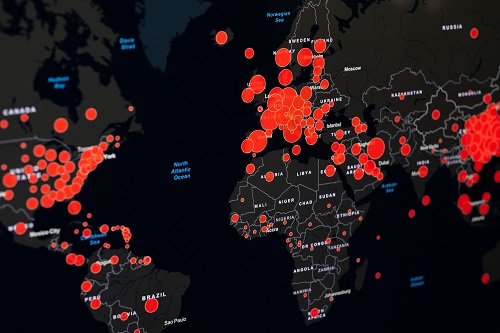There is no lack of information available today about the risks of COVID-19.
Rarely does a news broadcast pass without the latest numbers on cases, hospitalizations, and deaths, accompanied by serious commentary from high-ranking medical and scientific professionals.This information should help people understand the threats from this virus and, ideally, inspire them to comply with measures to mitigate infection risk.
Unfortunately, compliance is not turning out to be universal. Even public officials have been bending the rules. Indeed, a recent study from the U.K.-based behavioral science consultancy Dectech1 found that nearly a third of those surveyed had spent time with someone outside of their household despite restrictions on such socializing.
Insurers face a similar problem. Many families are underinsured, suggesting that perhaps they do not see the value of such financial protection, or their risk in not having it. Buying insurance is an action people can take to mitigate their financial risk, but the hoary adage ”insurance is sold, not bought” shows that it is still harder to get consumer engagement than it should be.
Is the problem that people just don’t understand the risks of this pandemic, or risk in general? A handful of studies published since the summer have examined the psychology of how the public perceives the pandemic’s risks. What can these results tell us about the public’s perception of COVID-19 risk, and how can this information help insurers understand consumer mindsets and needs?
Understanding the threat of COVID-19
When people understand a reasonable threat exists they will generally be more likely to take actions to avoid it. This was shown to be the case during 2014’s avian flu epidemic,2 and COVID-19 research has consistently been telling a similar story – the larger the threat people feel, the more likely they are to take protective measures such as washing hands, wearing masks, social distancing, and even panic shopping.
But the bigger challenge may well be the public’s sense of the threat in the first place. In one U.S. study,3 half of the respondents substantially underestimated their risk of dying if infected. Perhaps more worryingly, older respondents and individuals with underlying health conditions also underestimated the virus’s potential threat despite understanding they were at higher risk than the population average.
A well-established finding from behavioral economics is that humans are often poor at understanding their own risk objectively. For example, a majority of people implausibly believe they are better than average drivers,4 and many also believe their chances of avoiding cancer are better5 than other people’s, despite no objective basis for the belief. This comparative optimism – the belief that negative events are more likely to happen to others– might also explain how people are perceiving the risk of COVID-19. A study early in the current pandemic on perceived risk and self-reported personal behavior conducted by researchers at the California Institute of Technology6 found that participants perceived a high level of risk to the general population but tended to rate themselves as being at lower risk than the average person. It is worth noting that this perception was not influenced by whether or not the respondents were actually at lower risk than average.
This finding, replicated by a group of researchers from the U.K., U.S., Europe, and Australia7 using the U.K. data, also suggests that despite the inescapable factual information available about COVID-19, people still believe ”it won’t happen to me.”
Perhaps most interesting is the finding that factors beyond objective facts can and do influence COVID-19 risk perception. According to a study from the University of Cambridge8 of almost 7,000 individuals in 10 different countries, although participants had relatively high threat perception, men, who are statistically far more likely to die from COVID-19, were less likely to report feeling threatened by the pandemic than women. The researchers also found that risk perception can be amplified by how a person’s friends and family are perceiving said risk and by their having existing prosocial values (values that promote behavior benefiting society as a whole). The Cambridge study also showed that the most powerful predictor of COVID-19 risk perception was direct personal experience with the disease.
Clearly, despite all the objective information we have at our disposal, visceral experiences, i.e., concrete evidence obtained and interpreted through our own senses, emotions, social interactions, and existing attitudes, are powerful drivers of people’s reactions to external threats.
Is risk knowledge or a feeling?
These studies paint a picture of reactions to the COVID-19 pandemic that are consistent with psychologists’ view of risk perception: perceiving a threat may push people to take action, but perceiving a threat accurately is not guaranteed. While perception of COVID-19 risk is relatively high on the scales used in the studies, it is still underestimated and subject to biases such as over-optimism and social influence, and context such as pre-existing worldview, direct personal experience, and gender identity.
Risk, to humans, is subjective – fundamentally about what one is feeling. Fear, disgust, and the prospect of guilt and regret turn people away from danger, and when not sure how to respond, humans look to other people’s behavior and their own expectations for answers. This is how people experience the world first-hand, and this experience, rather than objective facts, frequently dominates judgements and decisions.
To understand the physical effects of COVID-19, seeing someone in a hospital bed who is either intubated or on mechanical ventilation is likely to have a far more powerful visceral effect on a person than case numbers. People can empathize with the horror of the situation and grasp the risk in a way that knowledge of the numbers just cannot achieve.
Perhaps this was the idea behind one U.K. city’s campaign to promote compliance with COVID-19 restrictions. Its shocking slogan, “Don’t Kill Grandma,”9 sought to elicit an emotional response to promote a personal understanding of COVID-19’s risks rather than presenting statistics and then expecting a highly rational and analytical response.
Communicating to inspire protective action
Should communicators use shock tactics such as fear appeals to help people gain an appropriate understanding of risk? One of the most widely discussed uses of fear appeals, i.e., tactics designed to elicit emotional discomfort and motivate particular responses, are the campaigns to push smoking cessation. Cigarette packets in the U.S. are required to display warning messages, and in the U.K., must have both warning language and harrowing images of the physical effects of smoking, in the hopes that user exposure to these horrifying images may promote behavior change.
Fear appeals can be effective,10 but there are serious caveats.11 Overly shocking communications can make people disengage12 and ignore or react defensively to the intended message altogether. Finding the right balance of engaging emotions while sustaining people’s attention is vital for risk communicators. In particular, being able to show that a risk is personally relevant and that one’s own actions can minimize the danger of a particular risk are key elements of making fear appeal messages work.
Insurance marketers face a similar challenge in persuading consumers to protect their assets and finances. It can be off-putting to communicate risk by scaring potential customers. Also, the industry is dominated by a highly objective and numbers-based understanding of risk, but as the COVID-19 research shows, people do not usually think of risk statistically.
Insurers can learn from the COVID-19 research that while it is difficult for people to appreciate intangible risks, communicating risk in terms of lived experiences, whether their own or that of others, might be a powerful tactic. From this perspective it is unsurprising that insurance sales increase in response to emotively striking but objectively unimportant events, such as widely reported floods leading to increased insurance demand in unaffected areas13, and the death of Kobe Bryant14 generating a spike in life insurance sales. For insurers, this might mean finding ways to approach customers at moments when risk events are salient and emotionally resonant – when such events and people’s interactions with the information are spurring thinking about caring for their families, health and homes. These could be important opportunities for demonstrating the value of insurance products.
COVID-19 communications and insurance marketing share the same conundrum. Objective risk for humans is often intangible. Insurers seek to understand and communicate health and financial risk objectively, but also need to acknowledge that customers might not receive that objective message. Exposing the risk by creating or exploring feelings that resonate with lived experience, identity, and expectations are going to count for far more than just bare facts.



